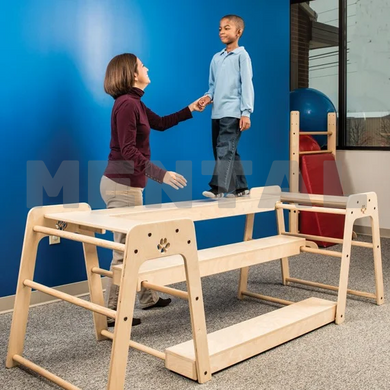|
Quantity
|
Out of stock
|
||
|
|
|||
Balancing platform.
A multi-level balancing platform is used for disorders of the vestibular system.
The goal of balance platform exercises is to improve balance while walking.
First of all, we are interested in the development of reciprocal connections and integration between the two hemispheres of the brain and between the two sides of the body that they control, and not in teaching a child to walk on a balancing platform without falling. As we increase the demands on maintaining balance while performing the exercises, we increase the demands on the system of integration of the two separate sides. The higher the level of balance, the higher the level of integration required for adequate performance.
When a child learns to balance while walking on a balance platform, it does not always provide a significant training effect, because there are two ways to perform the task. It can perform a task quite effectively by integrating two systems into one, or it can perform a task with tension by suppressing those parts of the systems that it cannot integrate or harmonize. If the child performs the exercise according to the last of the described samples, the therapy will not be effective. If a child uses a suppression model to complete a task, his trunk and limbs will be tense and stiff, and the movement he uses to maintain balance will be jerky. Because his body is tense, the child will expend an excessive amount of energy on the task, working against himself. To move, he would have to overcome the tension in his tight muscles. The suppression pattern can be changed by modifying the exercises. All training consists of relationships. In this regard, learning motor skills is no different from higher abstract thinking, which is provided by a certain model of relations. A certain scheme of connected movements provides the most effective ways of performing a motor task. In an abstract sense, we start with a concept and relate this concept to other concepts; the more broadly we consider it, the greater will be the coverage of the new concept and the more significant the solution to the problems. Motor development occurs according to the same scheme. We start with movement exercises and make small changes to them. When the child performs the first task and changes the movement pattern according to the changes in the task, he develops the first movement model. The more we develop, the more flexible the system will be because it will have many possibilities to respond. The main rule for perceptual-motor development is to use the largest number of related exercises. The system will choose the most effective possible response to solve the problem. There are many models of a child performing a task, such as walking on a balancing platform. Some are completely ineffective and require excessive energy consumption. Other models are more effective. The effectiveness of the motion model is determined by the relationship of the motion model to the laws of motion. The more in harmony with the laws of motion the motion model is composed, the higher the effectiveness of this model.
By using variations of the exercise on the balancing platform when performed by the child for the first time, we help him to expand the pattern of response and reduce the pattern of suppression. There will always be a certain amount of suppression, and by building a broad generalized system, we will greatly reduce this tendency.
Sometimes we think that perceptual-motor development is a simple low-level activity, something that does not require high intellectual activity. Observing how a child walks on a balancing platform and at the same time throws and catches polystyrene bags, considering the processes associated with the performance of this task, in the end, we will understand that this is not such a low-level action. When the child walks the balance platform, he must change the basic pattern of walking in such a way that the movement pattern for grasping the bag can be combined with the basic pattern of walking without disturbing the overall balance of the system. When a child walks and throws a polystyrene bag at a moving target, the basic walking pattern, the throwing pattern and the movement pattern of the moving target must be integrated. At the same time, the child must project his own movement; the movement of a bag in flight and the movement of a moving target. He must project where the moving target will be with the hour and throw the bag in such a way that it reaches the same point at the same hour. This is quite an achievement.
We are interested in the maximum possible integration of vision when performing exercises. Balance exercises help us build relationships between the two sides of the body and the two hemispheres of the brain that control each side. These exercises also help us establish a more subtle connection between visual and kinesthetic or motor modalities. If you stand on one leg and keep your balance, and then close your eyes and try to keep it, you will see the connection between vision and balance. If you stand on the log and close your eyes (be careful), you can see the meaning of vision in this position. Naturally, if you make balance exercises more difficult, you increase the demands on your vision.









